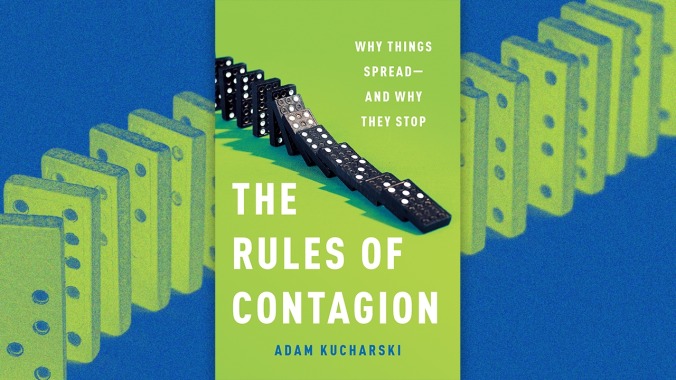“If you’ve seen one pandemic,” epidemiologists like to joke, “you’ve seen… one pandemic.” Influenza strains and common colds differ year to year. The H1N1, or swine flu, pandemic of 2009 does not perfectly parallel the H2N2 pandemic of a half-century earlier. HIV/AIDS does not correlate with the gonorrhea outbreaks of the 1970s. Despite what a profusion of articles and talking heads have told us over these past 100-plus days, COVID-19 is very different from the influenza pandemic of 1918-19.
Each disease outbreak is its own unique set of social, historical, as well as infectious circumstances. Yet, Adam Kucharski writes in The Rules Of Contagion: Why Things Spread—And Why They Stop, by separating particularities (symptoms, prevention methods, government response) from principles (the very viral nature of viruses), epidemiologists can learn to outthink outbreaks. Diseases need not be mysterious.
A mathematician at the London School Of Hygiene & Tropical Medicine, Kucharski studies the dynamics of infectious diseases, mapping and graphing flu outbreaks and Ebola epidemics. His book arrived in the U.K. on February 13, two weeks after the first confirmed cases of COVID-19 there. It arrives here, in the U.S., as coronavirus numbers continue to soar, five months too late to be read by the mostly maladroit members of Trump’s Coronavirus Task Force, but soon enough for whomever replaces—the sooner the better—that administration’s death-dealing kakistocrats.
In the mode of pop tech writers like Michael Lewis, Steven Johnson, and Malcolm Gladwell, Kucharski combines science and history with a bit of immersive journalism to enliven what might otherwise be a dreary subject. Like those bestselling authors, Kucharski weaves in interesting asides—“abracadabra” was originally a Roman spell to ward off malaria—and builds his narrative around a complicated hero that such books require.
Enter Ronald Ross, a medical doctor who, while treating fevered patients in British colonial India, became among the first to link malaria with mosquitos. He’d win the second ever Nobel Prize in Medicine for his research in 1902. But in Kucharski’s estimation, Ross’ grandest achievement was for what he named his “theory of happenings,” which, though it sounds useful in predicting the next Fyre Festival, simply proposed a general law of epidemics. This theory, Ross hoped, could tackle not only infectious diseases but most anything that spreads, including social behaviors.
Ross’ theory remained just that, theory, until the 1970s, when the mathematician Klaus Dietz conceptualized what would become known as the reproduction number—R for short—or the average number of new infections to be expected from any given infectious person. A disease with an R of 2 indicates that the average infected person will likely infect two additional people. If the reproduction rate is over 1, there is a high potential for an epidemic to occur. Smallpox, for instance, has an R of 4 to 6. Chickenpox: R=6-8; Ebola: R=1-2; COVID-19, with zero control measures: R=2-3.
Research scientists, epidemiologists, and otherwise have since used the theory of happenings to calculate the reproduction numbers of obesity, suicide, smoking, mass shootings, opioid addiction, and even yawning. Some of these studies, like those of shootings in Chicago (R=0.63, similar to the reproduction number of cholera in Bangladesh), were well-publicized. Some are odd: Several studies show that yawning is contagious among intimates but not strangers. Others, like a 2012 study on loneliness, arguably deserve more attention. Lonely people cut friend ties, researchers found, “but before they do, they tend to transmit the same feeling of loneliness to their remaining friends, starting the cycle anew.”
The book’s second half examines less conventional but certainly more commonplace contagions, that is epidemics we don’t have to leave our computer screen to encounter. Studies show that fake news and online conspiracies operate much like viruses (popular Facebook posts have a reproduction number of around 2). But researchers have also demonstrated that repeated exposure can stimulate positive political and social change. A 2016 study by a pair of political science grad students at Berkeley found that a 10-minute conversation about transgender rights could dramatically reduce prejudice. Like viruses, they found, our beliefs are mutable.
The Rules Of Contagion will interest those seeking insight into COVID-19, of course, but it’s impossible to read the book without reflecting on the Black Lives Matter protests that have flared up since the killing of George Floyd in late May. Viral cellphone videos of police brutality and murder incite people to take to the streets, but also—as my experience shows—invite the opportunity to productively talk about America’s history of systematic racism among family and friends with whom, for any number of reasons (discomfort, ignorance, racism itself), the subject never came up.
No telling what the reproduction number of spreading progressive ideas among one’s racist relatives is—political scientists are no doubt crunching the data now. But we all know the danger of not engaging with viruses, whether of the body or of the mind. If you’ve seen one pandemic, it might be said, you’ve seen them all.













![HBO teases new Euphoria, Larry David, and much more in 2026 sizzle reel [Updated]](https://img.pastemagazine.com/wp-content/avuploads/2025/12/12100344/MixCollage-12-Dec-2025-09-56-AM-9137.jpg)



























